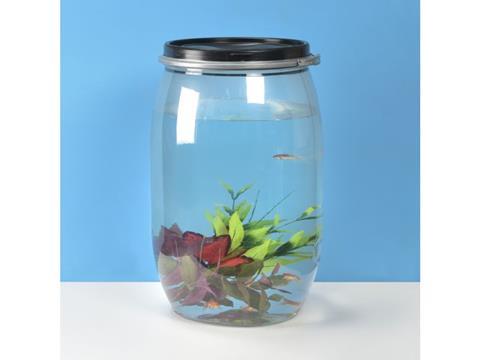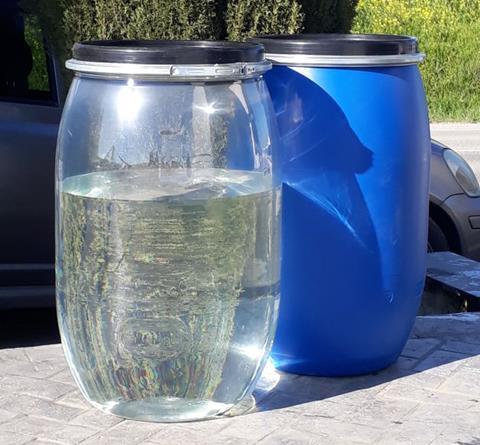
The countdown is on for the live Sustainability Awards 2019 ceremony, where we will unveil the worthy winners of the most prestigious sustainability competition for packaging innovation.
In anticipation, we explore the 25 standout solutions that made it to the finals, handpicked by our independent, expert judging panel.
Today, we speak with ‘Resource efficiency’ finalist CYPET Technologies’ managing director Constantinos Sideris, and find out more about the company’s 120 litre drum made from PET material, using a special process, which can offer better recyclability, lighter weight and more energy efficiency during production.
The winners in each category and overall 2019 Sustainability Awards winner will be announced at FachPack, Nuremberg, Germany on 25th September. Join us from 16:30 at FachPack’s PackBox Forum for sustainability discussion, networking, drinks and the big reveal.
- Could you please introduce your successful initiative / innovation?
CYPET Technologies’ innovation is the production of a 120 Litre drum made from PET material, using its energy efficient single stage injection stretch blow moulding technology. This drum is the largest blown PET container in the world, produced using the lowest amount of energy. Conventional technologies that process PET material cannot produce PET containers larger than 30 litre in size in a commercially viable way.
With CYPET Technologies’ system, PET containers can enter the packaging market for bulk transport of liquids, powders and granular materials, that has so far been dominated by HDPE drums. PET drums offer a lighter weight and environmentally attractive alternative to HDPE Drums.
- What are the environmental challenges in packaging that your entry addresses, and how well is the market responding to them so far?

Several environmental challenges are addressed by our entry:
A 120 litre PET drum weighs 20 % less than an HDPE drum of the same size, so there will be a significant reduction in plastic material consumption in the drums market just by switching from HDPE to PET.
PET drums produced on a CYPET system need much less energy to be manufactured. This is because of the system’s very low electricity and air consumption. CYPET has measured an electricity consumption of 0.36kWh per kg of plastic processed whereas Extrusion Blow Moulding machines that work with HDPE consume on average 0.8kWh per kg of plastic processed.
PET recyclability is more sustainable than HDPE. PET can be upgraded during the recycling process to bring its properties back to their original levels, including the suitability for food contact applications after recycling. HDPE cannot recover its properties back to the original ones, so recycled HDPE cannot be used for the same applications as virgin HDPE.
PET drums have a smoother surface than HDPE. This results in more effective and easier cleaning using less amount of water and cleaning agent before re-use of the drum.
Blown PET containers have better stress crack resistance than HDPE containers. This is expected to result in a reduction of damaged drums from environmental wear, which will reduce the plastic wastage from broken drums.
Blown PET containers have better gas barrier than drums, so for foodstuff applications that are sensitive to oxidation, the product can be kept fresh for a longer period, which is expected to reduce product wastage.
- ‘Sustainable packaging’ is a contentious concept, which means different things to different people, and anyone working in packaging understands that it’s easy to make things worse according to one environmental metric while making improvements according to another. In your opinion should there be a hierarchy among our sustainability goals?
In our opinion there should be a hierarchy in sustainability goals, in order to ensure that the sustainability problem is solved in a structured (and therefore efficient) way. The key is setting a balanced weighting on the different goals and here is where all stakeholders need to be involved to achieve the right balance. One such high priority goal, for example, would be using packaging materials that are truly circular, i.e. can be used for the same application after recycling, over and over again.
- Clearly, sustainability in packaging needs to be achieved by many stakeholders acting together, not by someone with a silver bullet. Thinking about the wider picture, what areas of innovation or action would you like to see across the value chain in the coming years to meet the demands of nature and society?
There are many innovations/actions that we would like to see, that can happen in parallel:
- Effective incentives to strengthen the recycling culture in consumers
- Recycling systems and technologies that make it easy and more economical to recycle packaging
- Development of more energy efficient technologies to process packaging materials
- Development of new containers that are more easily recyclable (for example containers with integrated handles or caps and containers that are of the same material and don’t need separating during recycling)
- Development of more environmentally sustainable materials (biodegradable, ability to re-use having the same properties etc)
- Better communication between the different stakeholders of the value chain so that new solutions are developed considering the entire chain rather than optimising a specific part of the chain at the expense of another part.










